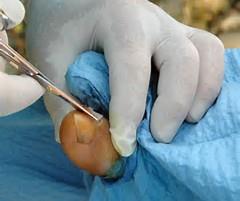Ingrown toenails are a common affliction that many people suffer with. An ingrown toenail can affect people of any age, from children to adults and has many potential causes. Everyone who has had an ingrown toenail can tell you how painful they can be.

An ingrown toenail occurs when the skin starts growing over the toenail, or the nail starts growing into the flesh. Ingrown toenails are very common in children and teenagers, and any toe can get an ingrown toenail, but it most commonly occurs on the big toe.
What are the Symptoms?
The symptoms of an ingrown toenail will change depending on how far progressed the issue is. For example, a toe that has only just started to get an ingrown toenail will become stiff, swollen and tender to the touch.
If left untreated or if home treatments are unsuccessful, the ingrown toenail will worsen, resulting in redness, pain, infection and even discharge. Toenails that reach a particular stage of disease will likely need interventions from a children’s or sports podiatry clinic, require antibiotics and may need ingrown toenail surgery.
How can you prevent them?
Unfortunately for some, it may not be possible to prevent ingrown toenails. Some people, by their genetics, have toenails that are too big for their toes.
For the rest of us, the best preventions are to protect the toes. Wearing shoes and socks that fit correctly and saving the toes from direct trauma, such as dropping objects on them or stubbing the toes, are the best preventions. If your ingrown toenail results from a sports injury, it is likely to be more severe, and you should get advice from a sports podiatrist immediately.
Children and teenagers are particularly vulnerable, and their parents should pay close attention if their toes get injured or their children start complaining of discomfort.
Cutting your toenails incorrectly can be another cause of an ingrown toenail. The correct way to cut a toenail to prevent it from becoming ingrown is to cut it straight across and not curl it down on the edges. Further, please do not cut the nail too short; keep it to the length of the toe.
How do you treat them?
Depending on the severity, ingrown toenail treatment can occur at home or may require a podiatrist to intervene. The key is to intervene as soon as the ingrown toenail is noticed so that it doesn’t worsen and require surgery. If the ingrown toenail is on your child or teenager, it may be best to visit a children’s podiatry clinic first.
At Home
So, what are some of the ingrown toenail treatments you can try at home?
• Keep the toe exposed to the air so that it stays dry; if you must wear shoes, make sure they are comfortable with plenty of room.
• Soaking the foot in warmish water a few times a day.
• Dry the foot properly after showering and keep it dry throughout the day.
• Use over the counter pain relief to manage any pain.
These treatments will work for early-stage ingrown toenails. However, if your toe is more than just uncomfortable and causing you pain or looking infected, then you should contact a podiatrist immediately.
Surgery by a Podiatrist
A children’s podiatrist, sports podiatrist or regular podiatry clinic needs to be involved if an ingrown toenail surgery is required. Ingrown toenail surgery consists of an injection of a local anaesthetic in the toe followed by the partial or complete removal of the nail and possibly the nail bed. The extent of the removal will depend mainly on the current condition of the ingrown toenail and any infection.
Complete removal of the toenail may result in it growing back malformed, and it may take 3-4 months before it has fully grown back.
Suncoast Podiatry has several foot and nail clinics located on the Sunshine Coast, Queensland, Australia. If your ingrown toenail symptoms have persisted for more than 2-3 days, then it is time to get expert advice and treatment from one of the clinics. We have clinics in the towns of Noosa, Cooroy, Bli Bli and Gympie.
Contact us if you have ingrown toenails so that we can provide advice on the best remedy.
